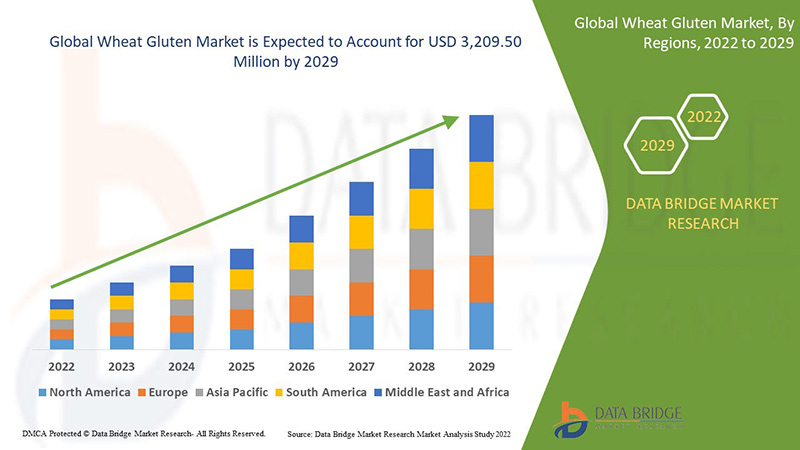Wheat gluten is a protein found in wheat, barley, and rye that gives dough its elasticity and helps it rise during baking. It is composed of two main proteins, glutenin, and gliadin, which combine to form a complex protein network. This network provides structure and texture to baked goods, making them chewy and elastic.
Global Wheat Gluten market insights
- Some grains, including wheat, barley, and rye, naturally contain the protein called gluten. Gliadins and Glutenin protein components make up wheat glutens. Glutenins include inter-molecular disulfide contacts, whereas gliadins contain a single polypeptide chain linked by hydrogen bonds, hydrophobic bonds, and intra-molecular disulfide interactions.
- Wheat starch and wheat gluten are two crucial co-products created during the wet processing of wheat flour from an economic standpoint. Wheat gluten is mostly used in baked pastries and processed meat products as a common food ingredient,. It has special qualities like the ability to form an extremely extensible, elastic structure after being hydrated and combined, which is what gives bread dough its capacity to hold gas.
- According to data bridge market research, the global wheat gluten market is expected to gain market growth in the forecast period of 2022 to 2029. Data Bridge Market Research analyzes that the market is growing with a CAGR of 7.5% in the forecast period of 2022 to 2029 and will reach USD 3,209.50 million by 2029.
- For more insights on the global wheat gluten market visit https://www.databridgemarketresearch.com/reports/global-wheat-gluten-market
Why Is Wheat Gluten Important in Baking?
- Gluten is important in baking because it provides structure and elasticity to the dough. When bread dough is kneaded, the gluten forms a network that traps air bubbles and allows the dough to expand as it rises. This gives bread its characteristic chewy texture and helps it rise and hold its shape during baking.
- Gluten also plays a role in the flavor and color of bread. As the dough ferments, the yeast produces compounds that give bread its distinctive flavor, while the Maillard reaction that occurs during baking gives bread its golden brown color.
Wheat Gluten and Celiac disease
- While wheat gluten is a key ingredient in traditional bread and pastry recipes, it can also cause problems for people with gluten intolerance or celiac disease. Gluten intolerance is a condition where a person experiences symptoms such as bloating, abdominal pain, and diarrhea after consuming gluten. Celiac disease is an autoimmune disorder where the ingestion of gluten leads to damage to the small intestine, which can cause malabsorption of nutrients and other health problems.
- However, for people with celiac disease or gluten intolerance, consuming gluten can cause a range of health problems. In these individuals, the immune system reacts to gluten as if it were a foreign invader, causing inflammation and damage to the lining of the small intestine. This can lead to a range of symptoms, including abdominal pain, bloating, and diarrhea.
The popularity of gluten-free diets and products.
- As a result, there has been a rise in the popularity of gluten-free diets and products. Gluten-free alternatives to wheat flour, such as rice flour, almond flour, and coconut flour, have become widely available, and many restaurants and food manufacturers now offer gluten-free options.
- Research into wheat gluten is ongoing, with a focus on developing new methods for processing and modifying gluten to create healthier and more sustainable food products. For example, researchers are investigating ways to reduce the allergenicity of wheat gluten, as well as developing plant-based alternatives to gluten for use in baking and food manufacturing.
Alternatives of wheat gluten
- There are several alternatives to wheat gluten for baking and cooking for people with celiac disease or gluten intolerance, or for those who follow a gluten-free diet. Some popular alternatives include:
- Rice flour: Rice flour is from ground rice and has a mild flavor. It is a good option for use in gluten-free baking, particularly for cakes and cookies.
- Almond flour: Almond flour is from ground almonds and has a nutty flavor. It is a popular alternative to wheat flour. To use in gluten-free baking, particularly for baked goods that require a denser texture.
- Coconut flour: Coconut flour is from ground coconut meat and has a slightly sweet flavor. It is high in fiber and low in carbohydrates. Making it a popular option for use in gluten-free and low-carb baking.
- Quinoa flour: Quinoa flour is from ground quinoa seeds and has a nutty flavor. It is a good source of protein in gluten-free bread recipes.
- Buckwheat flour: Buckwheat flour is from ground buckwheat and has a slightly earthy flavor. It is a good source of fiber and protein in gluten-free pancakes and waffles.
- Potato starch: Potato starch is a fine powder of potatoes. It acts as a thickener in soups and sauces. It is also used in gluten-free baking as a substitute for wheat flour.
There are many other alternatives to wheat gluten available. Experimenting with different flours and starches can lead to delicious and healthy baked goods. It is important to note, however, that not all gluten-free products are equal. Some may still contain small amounts of gluten. It is important to read labels carefully and choose products that are certified gluten-free. If you have celiac disease or gluten intolerance.
Also, visit https://sohago.com/

